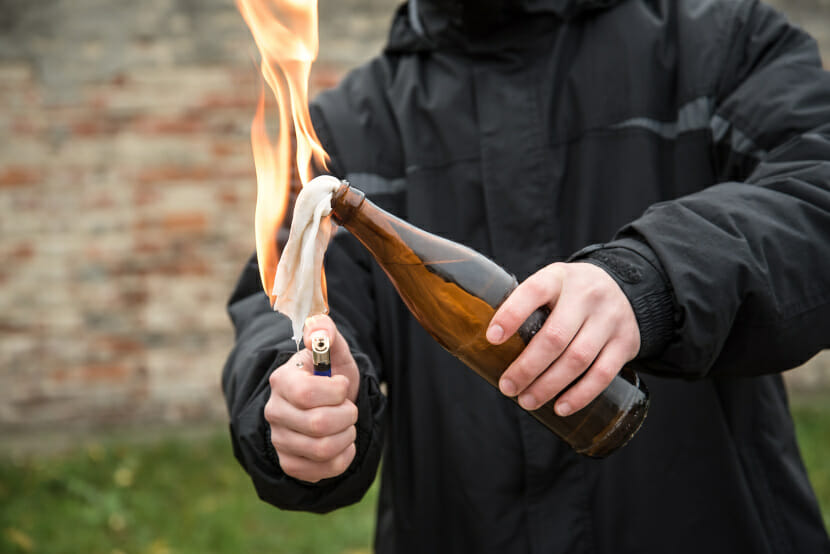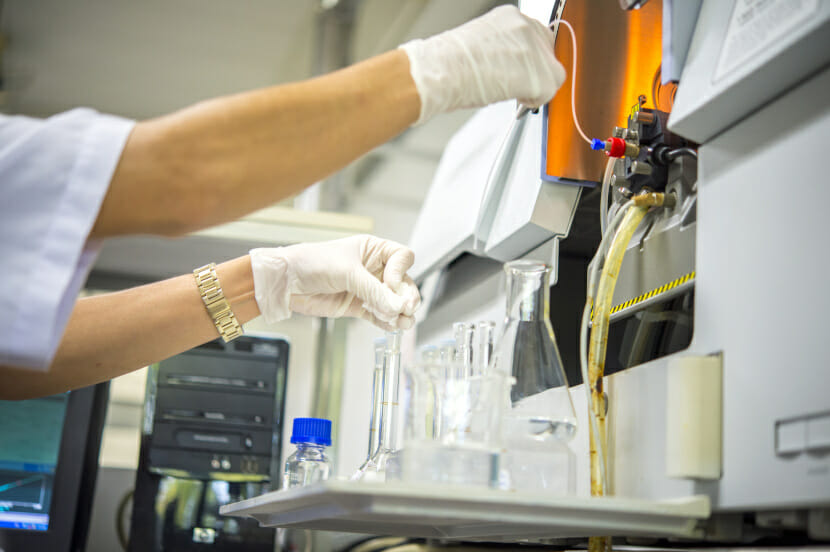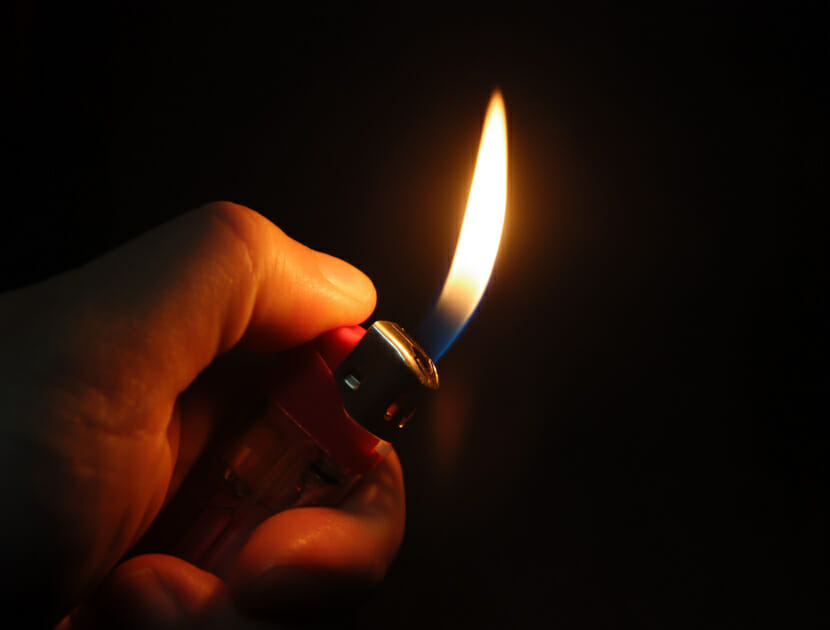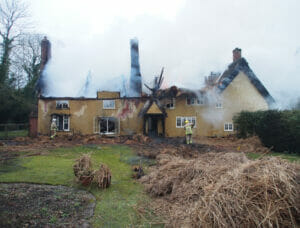Arson: A Burning Desire: Arsonists can cause not only serious injury and death, but also destruction to property and disruption to business. Arson can be a huge financial burden on insurance companies, the Police and Fire Service. It is an age-old crime that, by its nature, is hard for Police to investigate and for the Crown Prosecution Service to prosecute. Evidence at the scene can be destroyed, buried, or even overlooked. Arson’s devastating consequences can ruin lives and cause untold distress.
A key factor in catching an arsonist is the Police and insurers’ knowledge that a fire was deliberately ignited. In many cases, this is clear to all parties involved in an investigation from the outset, because physical evidence at the scene leads to that conclusion. Arson can be identified as the probable cause of a fire if multiple seats of fire, with no obvious link or accidental cause, are found. Examples of evidence to look for include:
- traces of flammable liquid residues with no legitimate source,
- an indication of forced entry by an intruder,
- the melted remains of a petrol container,
- burnt components from an incendiary device, or
- an incendiary device that failed to ignite as planned.
Any of these factors, or a combination thereof, can show that a fire was ignited deliberately.

Physical evidence at the scene of a fire can provide compelling evidence of arson, but other ‘softer’, more circumstantial evidence could also be present. For example, a failing business or a recently inflated insurance policy could indicate a potential motive for an arsonist. Other possible indicators include:
- Valuable or sentimental items might have been removed before the fire.
- Pets may have been protected deliberately from danger.
- High value items may have even been added to the location, or the amount of stock may have increased, before the fire.
- Planning permission to develop a site might have been recently refused.
- CCTV cameras might have been disconnected, or camera coverage modified recently.
- Sprinkler systems might have been deactivated or tampered with.
Alternatively, there could have been a series of unexplained or misdiagnosed fires, or a history of threats to a property, like drug-taking on site, squatting or even the cultivation of cannabis. Cultivation of cannabis is a hazardous process with a high risk of fire and can also make a property a target for arson by rival drug dealers. However, some fire scenes have no obvious sign of intruders, no missing valuables, no trace of flammable liquid residue and no plausible accidental cause. What can be done about the cases that initially leave investigators scratching their heads?
Excavating the debris at the scene to search for either flammable liquid residues or the remains of an incendiary device are important, but a thorough investigation of the circumstances of both the case and the background of the people involved is also vital. It can be critical to investigate suspicious information and glaring inconsistencies in witness accounts.
The doors of a building might have been secure when the Fire Service arrived, but what if a window was broken by an intruder and a petrol bomb had been thrown in to start the fire? What if petrol had been poured through a hole in the broken window? Pieces of glass will probably have fallen onto the ground, both inside and outside the building, when the window was broken. A careful archaeological-type excavation of the debris can reveal clean glass fragments with sharp edges, broken from impact rather than heat, which have been trapped and protected beneath the fire debris. A window broken before the fire, with no legitimate explanation as to why, raises the possibility of a break-in.
A metal door lock or lock plate might also be found within the debris. If the door was forced open by an intruder, there might also be characteristic indentations or striation marks in the metal left by a tool, such as a screwdriver or crowbar. A padlock might have been cut by bolt croppers, and the remains of any lock might be found only when the scene is thoroughly examined and excavated. There might even be the possibility of matching indentations on the cut shackle of the padlock to a particular pair of bolt croppers. Smoke witness marks might also show whether a door was left unlocked, or whether a security chain had been taken off before the fire. All these small pieces of physical evidence from a scene can create a clearer picture for a fire investigator.
When examining the scene of a fire, an investigator should ask themselves several questions, including the following:
- Is an electrical appliance a credible source of ignition?
- Is there physical evidence to show an appliance caused the fire?
- How long had the fire been burning when it was discovered?
- Was anything flammable moved to facilitate the spread of fire (such as wooden furniture, stacks of paper, or cardboard boxes)?
- Could the damage to the property have been caused without the use of an additional fuel source, such as flammable liquid?
Technical expertise in interpreting electrical evidence at a fire scene can assist the identification of the probable seat of fire and eliminate a suggested accidental electrical cause.
Along with the investigator’s trained eye at the scene of a fire, accelerant detection dogs are also a valuable tool in searching for flammable liquid residues. Dogs have a better sense of smell than humans, and trained accelerant detection dogs can find flammable liquid residues buried below layers of debris. The dogs are equipped with their own boots to protect them from sharp objects, and their handlers are skilled in directing their search and looking after their welfare. Dogs are also very useful for searching large areas for discarded containers outside of the immediate fire scene that might have been used to transport a flammable liquid to the scene of the fire.
Flammable liquid residues can be remarkably resilient at fire scenes because they impregnate absorbent material, such as carpets. During a fire, a carpet may be covered by falling debris and any unburnt traces of flammable liquid become sealed inside it. If the debris is excavated carefully, traces of the flammable liquid might be found. Gas chromatography-mass spectrometry (GC-MS) is a highly sensitive analytical technique for identifying the presence of flammable liquid residues in fire debris samples. However, great care must be taken in interpreting GC-MS results. Many household objects that burn in fires can either contain or produce similar chemical compounds to those that are present in common fire accelerants. Therefore, the interpretation of the results can be critical in deciding if volatile organic compounds were found in material legitimately present at the scene rather than from a deliberately added flammable liquid.

In fatal fires, the body of the deceased can provide valuable evidence that can help identify the likely cause of the fire. At post-mortem examinations, a badly burnt body with a broken hyoid bone in the neck can still provide evidence of strangulation, while a fractured skull can still show evidence of pre-fire assault.

Hands tied with electrical flexes with non-combustible copper conductors can show that the victim was bound before the fire was set. In more extreme cases, X-ray images might also reveal the presence of shotgun pellets or bullet fragments in a body. Debris underneath a body can also be protected from the worst effects of the fire, and can provide forensic scientists with unburnt clothing, or even part of a ligature, for examination. Most importantly, the airway and blood of the deceased will tell the pathologist and toxicologist if the deceased was alive and breathing in the early stages of a fire, or dead beforehand. Black sooty deposits in the nose, throat and lungs show that the deceased was alive when the fire started. Likewise, high levels of carbon monoxide and other products of combustion in the blood show that the deceased was breathing in fumes. However, clean airways that are free of soot, and blood devoid of high levels of carbon monoxide or other products of combustion, show that the deceased was already dead when the fire started.
Once an investigator is satisfied that the fire was started intentionally, what can be done to identify the perpetrator? DNA has been a revolution in forensic science since Professor Alec Jeffreys at the University of Leicester first used it in the 1980s to identify the killer of schoolgirls Lynda Mann and Dawn Ashworth. Its value in leading to the conviction of the guilty and the exoneration of the innocent is universally acknowledged. Not only can DNA provide evidence of corroboration, with the advent of the national DNA database, it is now an investigative tool that can provide the Police with a suspect’s name as well as the evidence to convict them.
Fires can be some of the hardest scenes for Police Crime Scene Investigators to examine because the fire destroys much of the evidence that would normally be found. However, physical evidence of the perpetrator sometimes survives the fire and can be recovered and analysed. Tests have shown that, in some circumstances, DNA can survive on items at low levels in fire scenes where the temperature is not high enough to degrade the DNA. It has been found on evidence such as matches, cigarette lighters and petrol cans. Gloves, balaclavas, and other items of clothing worn at the time can also yield valuable DNA if not destroyed in the fire. Fingerprints may have survived on items in or near to the scene and can be enhanced by chemical techniques to reveal ridge detail that can link them to a suspect. Insurance investigators can identify items that require further investigation or debris that could be sampled for traces of flammable liquid residue. Additional information from witnesses or the scene might identify new opportunities that were not previously explored.

Digital forensic evidence is particularly suited to the challenges of arson investigation. CCTV can be accessed by people other than the original owner of the system. Neighbouring premises might have cameras that captured the incident, or the footage might have been uploaded automatically to a remote server for later viewing. An arsonist might also be unaware of surveillance cameras near to the scene. CCTV at neighbouring premises, dash cams, Police and firefighters’ body-worn cameras, and street and business cameras might show the arsonist fleeing the scene just before the fire breaks out. Alarm systems, vehicle data, satnav systems, mobile phones, tablets, and smart watches can also all provide critical evidence to link an arsonist to a scene.
Digital evidence is also now an effective tool that can either corroborate or cast doubt on witnesses’ versions of events. Alarm systems might not have been set or could have been deliberately deactivated. Even a heater covered with combustible clothing and controlled by a timer can be set up to cause a fire. The well-known Police adage of, “motive, means, and opportunity,” appears relevant when investigating arson.
The key to catching an arsonist is to approach the investigation with an open mind, a systematic and thorough method, and most of all, a desire to seek out the truth. Only if all agencies involved in arson investigation cooperate and collaborate will the plague of arson be tackled effectively.
ABOUT THE AUTHOR
Justin Lewis is a forensic scientist who specialises in fire investigation. He has worked in criminal and civil forensic science for over 30 years and is an experienced expert witness. During his career with the FSS, Justin acted as an expert witness within criminal cases including murder, attempted murder, arson, rape, robbery, firearms offenses, burglary and criminal damage. He was the National Scientific Lead for Fire Investigation and was responsible for scientific standard setting in Case Assessment and Interpretation.





